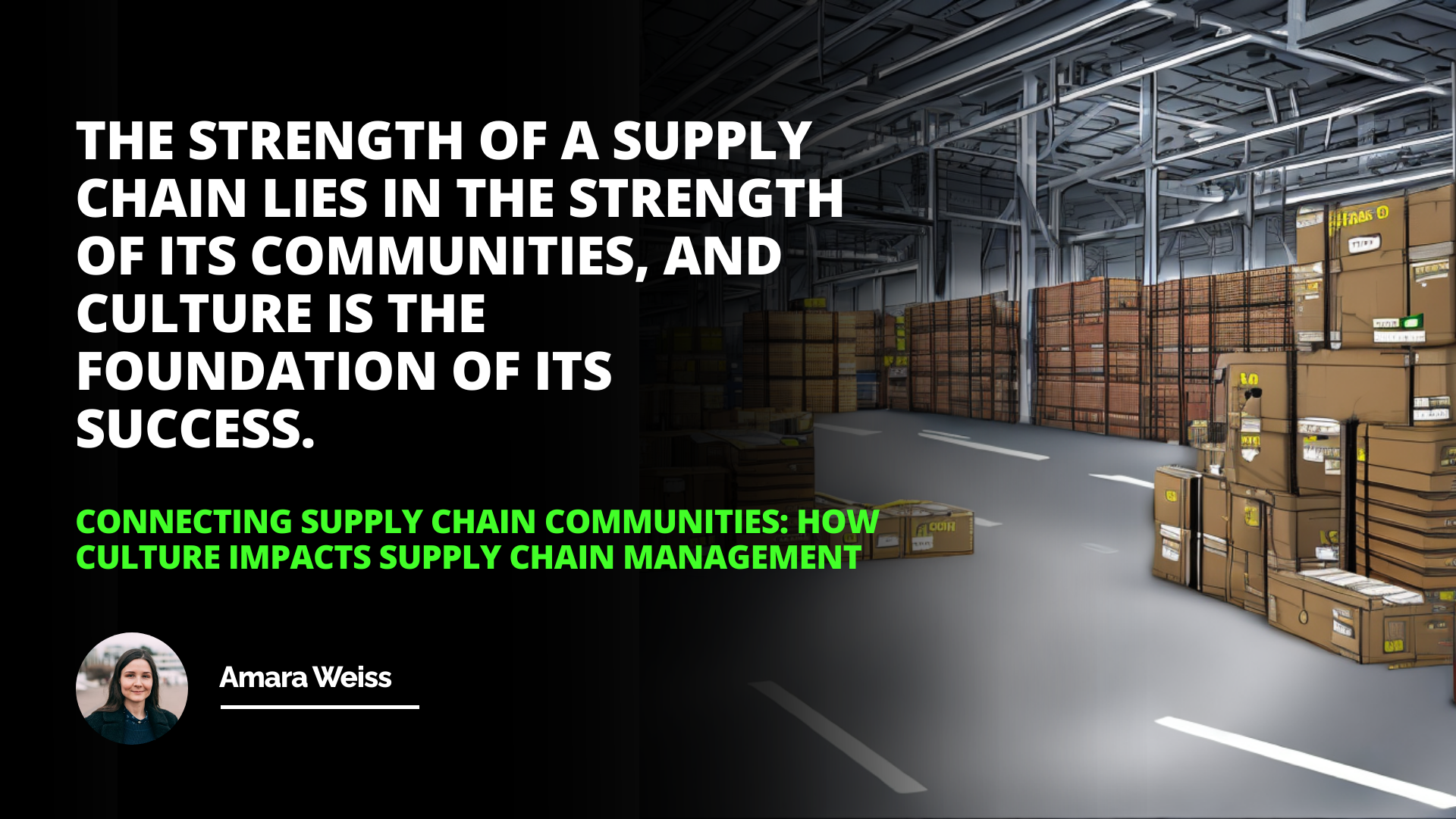
In this article, we explored the importance of culture in supply chain management, how to identify the cultural fit between customers and suppliers, and how to create an internal culture that supports supply chain management. Understanding the culture of both the customer and the supplier is essential for successful supply chain management, as it allows for better communication and collaboration between the two parties.
By creating an internal culture that supports supply chain management, businesses can ensure that they are well-positioned to create successful relationships with their suppliers.
Introduction
Understanding Culture in Supply Chain Management
Cultural Fit Between Customers and Suppliers
Internal Culture and Supply Chain Management
Conclusion
Introduction: The success of a business in the modern world depends largely on its ability to manage its supply chain effectively. A key factor in the success of any supply chain is the cultural fit between the customer and the supplier. Understanding the culture of both the customer and the supplier and how they interact is essential for a successful supply chain management strategy. In this article, we will explore the importance of culture in supply chain management, how to identify the cultural fit between customers and suppliers, and how to create an internal culture that supports supply chain management.
Understanding Culture in Supply Chain Management
Culture is an essential factor in any successful supply chain. The shared values, beliefs, and behaviors of a group of people define how they interact with each other and how they approach problems and make decisions. Just as individuals have different personalities, groups also have unique personalities. This collective personality is often referred to as the culture of the group.
In supply chain management, the culture of the customer and the supplier can have a huge impact on the success of the relationship. If the customer and the supplier have different values and beliefs, it can be difficult to find common ground and build a successful working relationship.
Cultural Fit Between Customers and Suppliers
When selecting a supplier, it is essential to consider the cultural fit between the customer and the supplier. It is essential to understand the values, beliefs, and behaviors of both the customer and the supplier and how they interact.
For example, if one of your customers values reliability, then a supplier that is known for its consistent quality will be a better cultural fit for that particular supply chain. On the other hand, if the customer values flexibility and innovation, then a supplier that is known for its ability to adapt and innovate quickly would be a better cultural fit.
Internal Culture and Supply Chain Management
In addition to understanding the cultural fit between the customer and the supplier, it is also important to consider the business's internal culture. The business's culture should support the supply chain's goals and objectives.
For example, suppose the goal of the supply chain is to provide high-quality products to customers quickly and efficiently. In that case, the internal culture should be focused on quality, speed, and efficiency. This could include employee training and development, rewards and recognition, and process improvement initiatives.
Conclusion: Culture is an important factor in any successful supply chain management strategy. Understanding the culture of both the customer and the supplier is essential for finding the right cultural fit. It is also important to consider the business's internal culture and ensure that it supports the goals and objectives of the supply chain. By understanding and leveraging the culture of all parties involved, businesses can create successful and sustainable supply chain relationships.
The strength of a supply chain lies in the strength of its communities, and culture is the foundation of its success.

Frequently Asked Questions
What are the key elements of understanding culture in supply chain management?
The key elements of understanding culture in supply chain management include identifying the cultural fit between customers and suppliers, understanding the culture of both the customer and the supplier, and creating an internal culture that supports supply chain management. This will allow for better communication and collaboration, and ensure that businesses are well-positioned to create successful relationships with their suppliers.
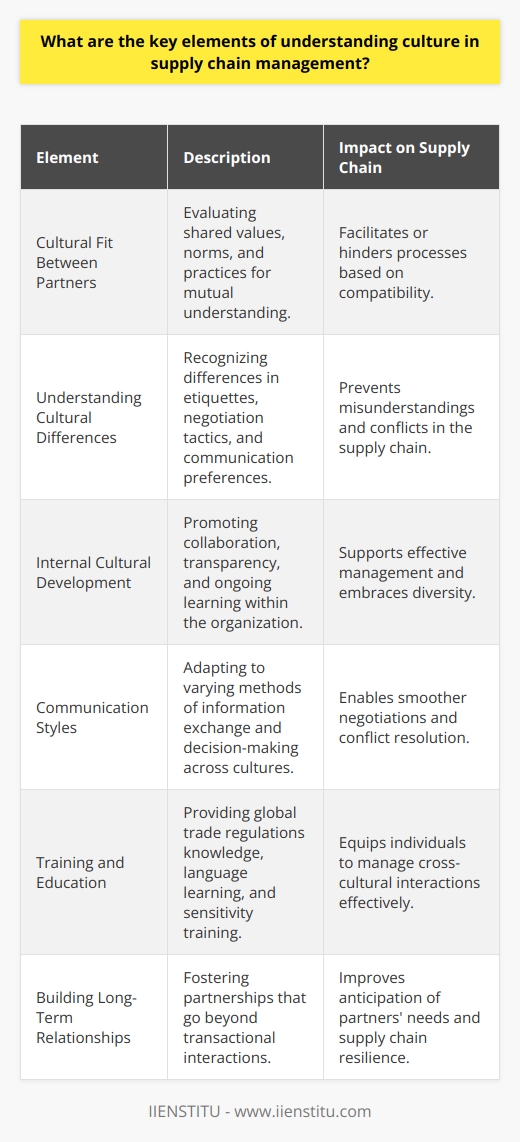
How does cultural fit between customers and suppliers impact supply chain management?
Cultural fit between customers and suppliers is essential in order to ensure successful supply chain management. When customers and suppliers have a strong understanding of each other's cultures, it allows for better communication and collaboration between the two parties. This understanding can also help businesses create an internal culture that supports supply chain management, making them well-positioned to create successful relationships with their suppliers. By recognizing the importance of cultural fit in supply chain management, businesses can ensure that their supply chain operations are efficient, effective, and successful.

What role does internal culture play in successful supply chain management?
Internal culture plays a key role in successful supply chain management. It is important to recognize the cultural fit between customers and suppliers to ensure that communication and collaboration are successful. Additionally, creating an internal culture that is supportive of supply chain management is essential for businesses to be well-positioned to establish successful relationships with their suppliers.
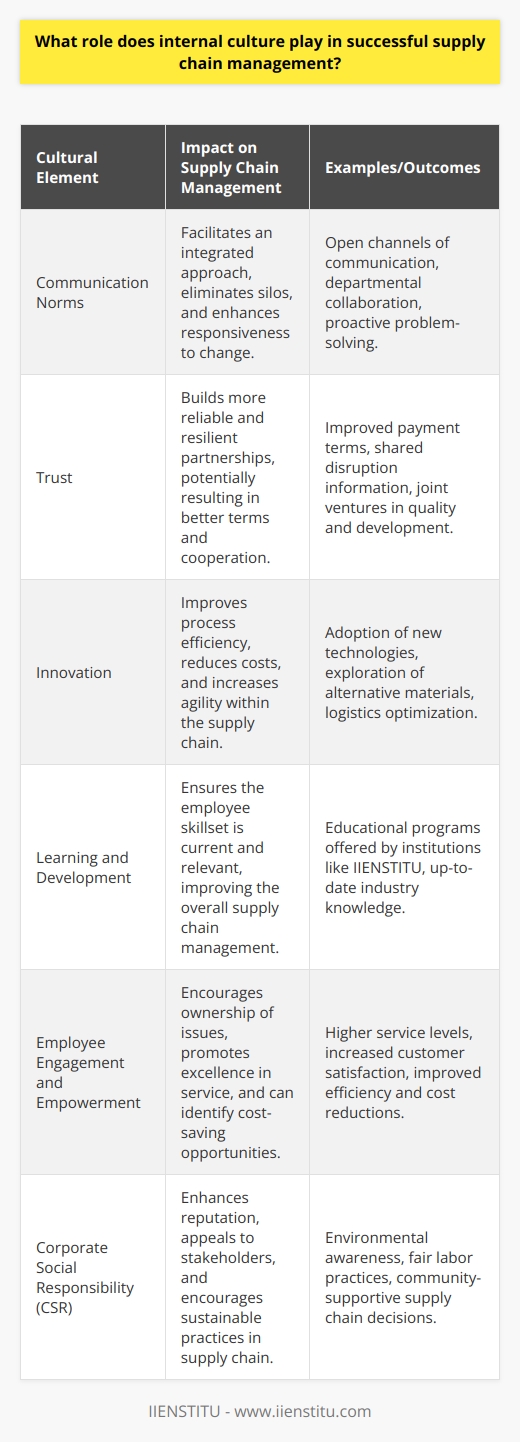
Why is culture important in supply chain management?
The Role of Culture in Supply Chain Management
Understanding Cultural Differences
Culture plays a vital role in supply chain management due to its effect on communication, negotiation, and decision-making. Cultural differences can impact supply chain partnerships, as communication styles, business practices, and organisational structures may vary between partners from different cultures. By appreciating the nuances of different cultures, supply chain managers can foster stronger relationships with suppliers and streamline operations.
Building Trust and Cooperation
Establishing trust and cooperation in a multicultural supply chain is crucial for effective collaboration. Supply chain managers must account for cultural sensitivities, such as differing views on the importance of personal relationships and the hierarchy within organisations. By acknowledging and respecting these differences, managers can facilitate a more harmonious working environment, leading to improved cooperation and shared success.
Effective Communication and Negotiation
Effective communication is essential in supply chain management, as it influences the ease with which partners can negotiate and make important decisions. Understanding the preferred communication style and language of each partner can greatly enhance the flow of information and reduce the likelihood of misunderstandings. Additionally, cultural awareness can help supply chain managers adapt their negotiation strategies to achieve mutually beneficial outcomes with partners from different cultural backgrounds.
Risk Management and Resolution
Being mindful of cultural differences within supply chain management can also aid in risk management and conflict resolution. By appreciating the factors that contribute to the decision-making process in different cultures, managers can be better equipped to work with supply chain partners to mitigate risks and address issues as they arise. This proactive approach can result in more effective problem-solving strategies and ultimately improve the overall performance of the supply chain.
Employee Engagement and Diversity
Lastly, embracing cultural diversity within the supply chain workforce can lead to higher employee engagement and innovative problem-solving. By fostering an inclusive environment that values diverse perspectives, supply chain organisations can benefit from enhanced creativity and more effective decision-making. This can result in a more agile and robust supply chain, capable of responding to dynamic market demands.
In conclusion, culture plays a vital role in supply chain management, shaping communication, negotiation, decision-making, risk management, and workforce diversity. By understanding and appreciating cultural differences, supply chain managers can build stronger partnerships, enhance collaboration, and ultimately drive success in an increasingly globalised business environment.
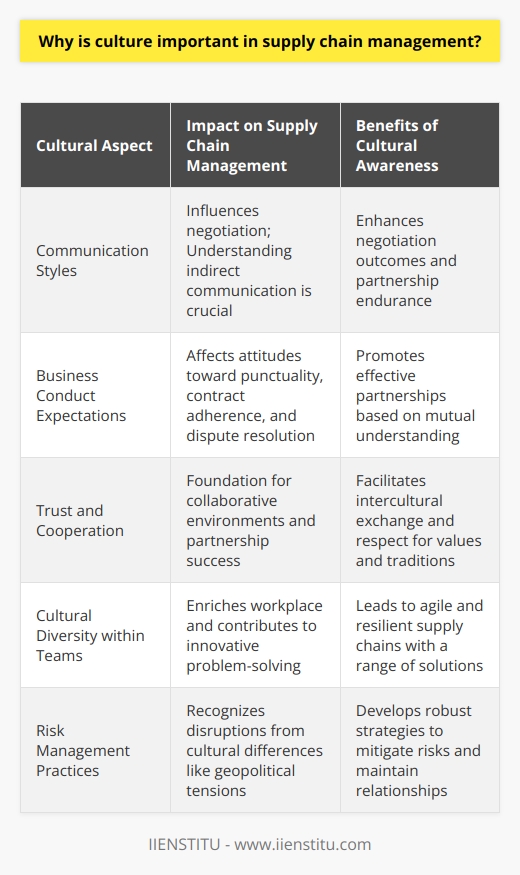
How does an effective supply chain management can help a community?
Efficient Utilization of Resources
Effective supply chain management (SCM) helps a community by ensuring efficient utilization of resources. It optimizes the allocation of local resources by enabling businesses to meet customer demand with minimal waste. As community organizations and businesses work together to share information, materials, and services, a well-integrated supply chain management system allows for coordinated efforts and reduced overall costs.
Local Economic Growth
When implemented correctly, SCM contributes to the local economy by fostering growth and providing job opportunities. Streamlined processes, improved inventory control, and enhanced communication with stakeholders often result in businesses expanding production and hiring more employees. Consequently, this stimulates job growth and creates positive economic outcomes for the entire community.
Environmental Benefits
Environmentally, effective SCM helps reduce a community's carbon footprint. By managing resources effectively, businesses can lower energy consumption and minimize waste production, positively impacting the environment. Additionally, a well-orchestrated supply chain can lead to sustainable practices such as recycling and upcycling. These eco-friendly initiatives contribute to a healthier, more sustainable community.
Social Responsibility
A well-managed supply chain supports a community by promoting ethical business practices and social responsibility. Ensuring fair labor standards, eliminating exploitative practices, and sourcing sustainable materials are all aspects of ethical SCM. When businesses and organizations work together to promote ethical and sustainable practices in their community, they create a more equitable and just environment for everyone.
In conclusion, effective supply chain management significantly benefits a community by ensuring efficient resource allocation, fostering economic growth, promoting environmental sustainability, and supporting ethical business practices. Implementing effective SCM systems and collaborating with stakeholders can lead to thriving, sustainable communities.
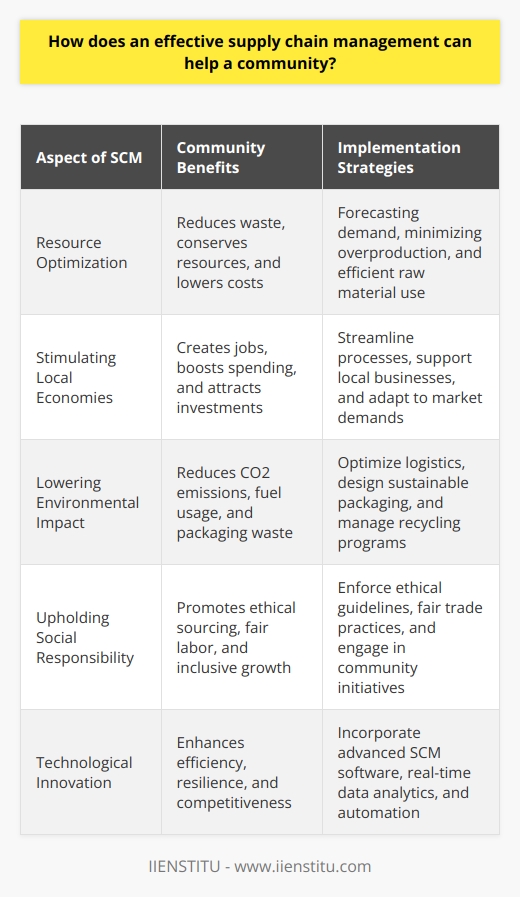
How can the chain relationship contribute to the success of supply chain management?
Impact of Chain Relationships on SCM Success
Effective collaboration and trust building
The chain relationship's contribution to supply chain management (SCM) success starts with effective collaboration between partners. By fostering open communication and mutual trust, companies can gain invaluable insights into each other's processes, which can help to identify areas for improvement and drive overall efficiency gains.
Risk management and mitigation
One key aspect of a successful chain relationship management is risk mitigation. By sharing information and collaborating closely with all members in the supply chain, businesses can anticipate changes in demand or potential disruptions and take necessary steps to mitigate their impact. This approach leads to more agile and resilient supply chain networks, better able to withstand market fluctuations and external pressures.
Increased transparency and visibility
Implementing effective chain relationship management practices promotes transparency and visibility throughout the entire supply chain. Organizations can track their products and materials through each stage of the process, from procuring raw materials to manufacturing and distributing finished goods. This enhanced visibility enables companies to identify potential bottlenecks or inefficiencies, leading to improved performance and cost savings.
Enhanced customer satisfaction
Customer satisfaction is also impacted by the effectiveness of chain relationships within supply chain management. When companies coordinate their efforts with suppliers and logistics providers, they are better able to ensure that products reach customers on time and in excellent condition. Close collaboration in the supply chain can also lead to better understanding of customer preferences, resulting in more accurate demand forecasting and better inventory management.
Creation of value-added services
An effective chain relationship can create opportunities for new and value-added services, such as integrated delivery and return solutions, customized packaging, or tailored payment terms. These services not only benefit the end customer but can also secure competitive advantages for the companies involved in the supply chain.
In conclusion, the chain relationship is a crucial factor in the success of supply chain management. Through collaboration, trust, and information sharing, companies can achieve more agile, efficient, and customer-focused supply chain networks. Investing in strong chain relationships may ultimately result in increased profitability and long-term business success.
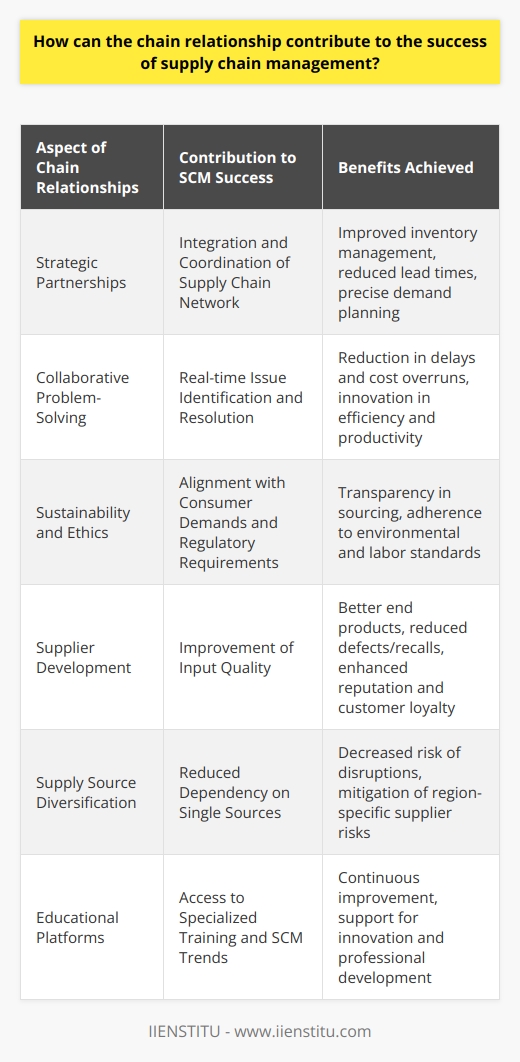
What is the impact of collaboration on a supply chain?
Impact on Efficiency and Coordination
Collaboration within a supply chain refers to the process of actively engaging with multiple organizations and stakeholders, including suppliers, manufacturers, distributors, retailers, and customers, to optimize a value chain's performance. Its impact on a supply chain can be seen in various aspects, including efficiency, coordination, risk management, and innovation.
Streamlining Information Sharing
One key area where collaboration improves supply chain efficiency is through enhanced information sharing. By embracing advanced communication technologies and platforms, stakeholders are better informed about demands, inventory levels, and lead times. Consequently, this helps to reduce the bullwhip effect, synchronize operations, mitigate stockouts, and ensure timely deliveries.
Managing Risks and Uncertainties
Moreover, collaboration promotes risk management by encouraging supply chain partners to share information about potential uncertainties and risks. Proactively identifying, assessing, and prioritizing these risks allows the supply chain to be more resilient and agile in response to disruptions in the market. Additionally, it helps develop alternative sourcing and manufacturing strategies when contingencies are needed.
Driving Innovation and Continuous Improvement
Furthermore, collaboration fosters an environment where supply chain partners can openly discuss their unique capabilities, expertise, and requirements. By openly engaging in such dialogue, stakeholders can explore opportunities for innovation in product development, process improvements, and technology implementations. As the supply chain network pool resources and share best practices, a culture of continuous improvement is created, leading to higher operational effectiveness and competitive advantage.
Enhanced Customer Satisfaction
Lastly, the positive impact of collaboration extends to customer satisfaction. The increased visibility and transparency of information in a collaborative supply chain assist in aligning stakeholder interests, meeting customer expectations more accurately, and responding to market changes more effectively. As a result, a demand-driven supply chain is created, which considerably shortens order-to-deliver time frames while improving product quality and performance.
In conclusion, the impact of collaboration on a supply chain is multifaceted, addressing challenges ranging from efficiency and coordination to risk management and innovation. By nurturing collaborative relationships among supply chain partners, businesses can effectively respond to ever-changing market conditions, drive innovation, and enhance customer satisfaction, ultimately giving the supply chain a competitive edge.
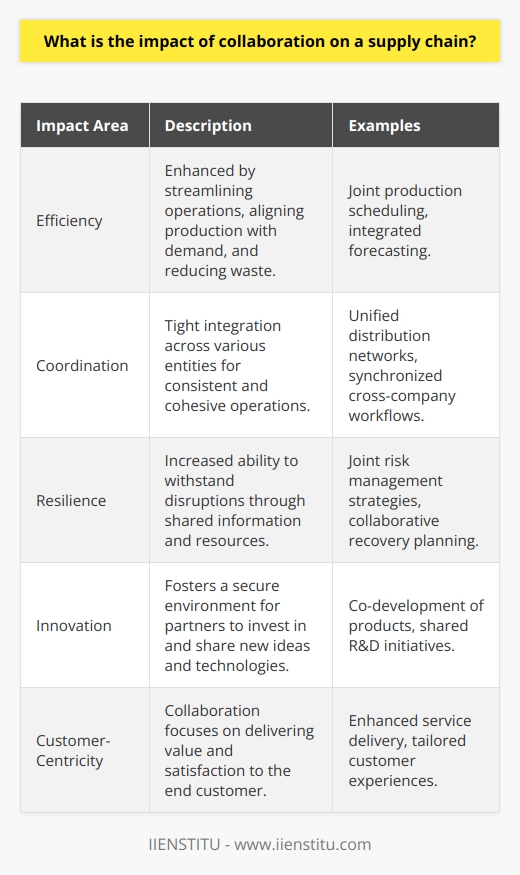
How do cultural differences affect global supply chain management?
Cultural Diversity in Supply Chains
Cultural differences significantly impact global supply chain management by influencing communication, negotiation, and decision-making processes. In multinational companies, employees and stakeholders often comprise diverse cultural backgrounds, leading to potential conflicts and misunderstandings that can hinder smooth operations. However, understanding and adapting to different cultures can enable organizations to build strong cross-cultural relationships, enhance collaboration, and ultimately, achieve greater efficiency and effectiveness in global supply chain management.
Communication Styles and Processes
One of the most apparent effects of cultural differences in global supply chain management involves communication styles and processes. Different cultures have distinct ways of expressing thoughts, opinions, and emotions, which can result in misinterpretations during negotiations or daily interactions. For example, high-context cultures, such as those in Asia and the Middle East, rely heavily on nonverbal cues and indirect communication, whereas low-context cultures, like the United States and Western Europe, emphasize explicit and direct language. To avoid communication breakdowns, supply chain managers must develop cultural sensitivity and awareness, adapting to and respecting different communication styles.
Negotiation and Decision-Making
Cultural differences also affect negotiation and decision-making in global supply chain management. Each culture possesses unique expectations and approaches when it comes to forging partnerships or making deals. For example, while some cultures highly value building personal relationships before engaging in business transactions, others prioritize efficiency and functionality. Additionally, decision-making processes may differ among cultures, with some preferring a hierarchical and structured approach, while others encourage open discussion and collaboration. Supply chain managers should recognize these cultural nuances and adapt their negotiation and decision-making strategies accordingly.
Adapting to Cultural Differences
In order to overcome challenges caused by cultural differences, global supply chain management must adopt measures that embrace diversity and facilitate cross-cultural understanding. Training employees in cultural competence and implementing diversity management policies can help bridge the gap between different cultures and ensure smooth communication and collaboration. Incorporating local expertise can also be beneficial in understanding specific cultural perspectives and practices. Ultimately, a proactive approach towards embracing and adapting to cultural differences will allow global supply chain management to optimize performance and achieve success across borders.
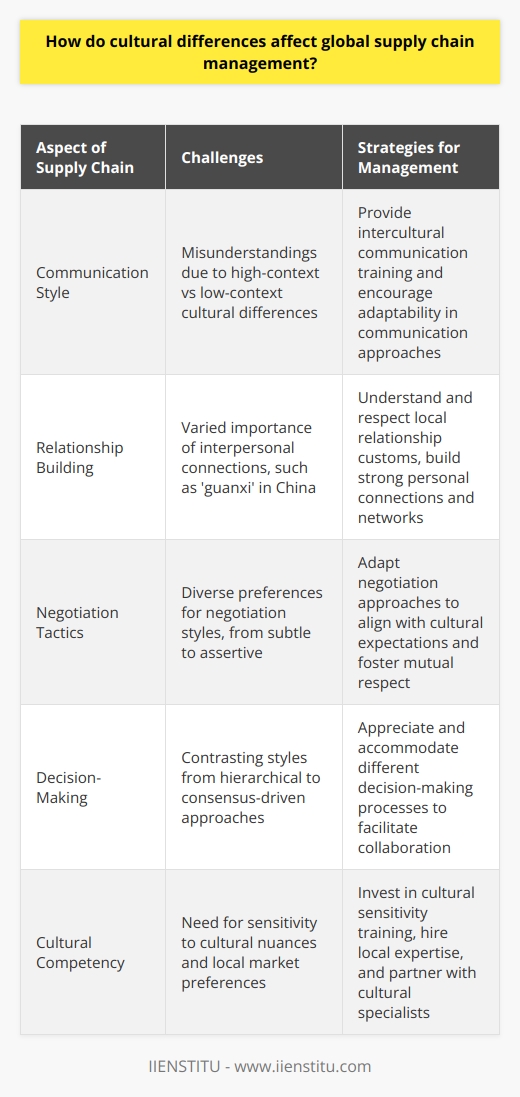
What is the relationship between supply chain resilience and cultural competency in supply chain management?
The Interrelated Nature of Resilience and Cultural Competency
Supply chain resilience refers to a company's ability to cope with disruptions and unexpected events, ensuring the stability and continuity of its operations. Cultural competency, on the other hand, involves being aware of and sensitive to cultural differences between various stakeholders in the supply chain. Both elements play a crucial role in the overall effectiveness of supply chain management, and they are interrelated in several ways.
Strong Connection
To begin with, supply chain resilience often necessitates the development of cultural competency within a company. Cross-border transactions and global collaborations are becoming increasingly common, making tolerance and respect for diverse cultures essential. Consequently, organizations must adopt a global mindset and develop appropriate cultural communication skills for effective collaboration.
Mutual Dependency
Furthermore, there is a mutual dependency between resilience and cultural competency in terms of risk management. When companies are culturally competent and well-informed about their partners' cultural norms, they are better equipped to understand potential risks and challenges. Accurate identification and mitigation of such risks contribute to enhanced supply chain resilience by improving collaboration and fostering trust.
Enhancing Supply Chain Performance
Moreover, embracing cultural competency enables companies to broaden their supply base, allowing them to work with suppliers from diverse backgrounds. This diversity contributes to an organization's agility and overall supply chain resilience, as it can accommodate a wider range of disruptions and market changes. Additionally, strong cultural relationships improve supplier relationships, leading to better supply chain performance.
Optimizing Decision-Making
Lastly, cultural competency aids in optimizing decision-making processes by promoting cultural understanding and reducing miscommunications. Consequently, it minimizes misunderstandings and streamlines the decision-making process, fostering effective supply chain resilience. Decision-makers who appreciate cultural nuances can address challenges and disruptions more efficiently, ensuring stability and continuity.
In conclusion, supply chain resilience and cultural competency are inextricably linked, with each element reinforcing the other. Developing cultural competency can enhance supply chain resilience through improved risk management, performance, and decision-making abilities. To thrive in today's increasingly globalized marketplace, companies must prioritize both supply chain resilience and cultural competency as integral components of their supply chain management strategy.
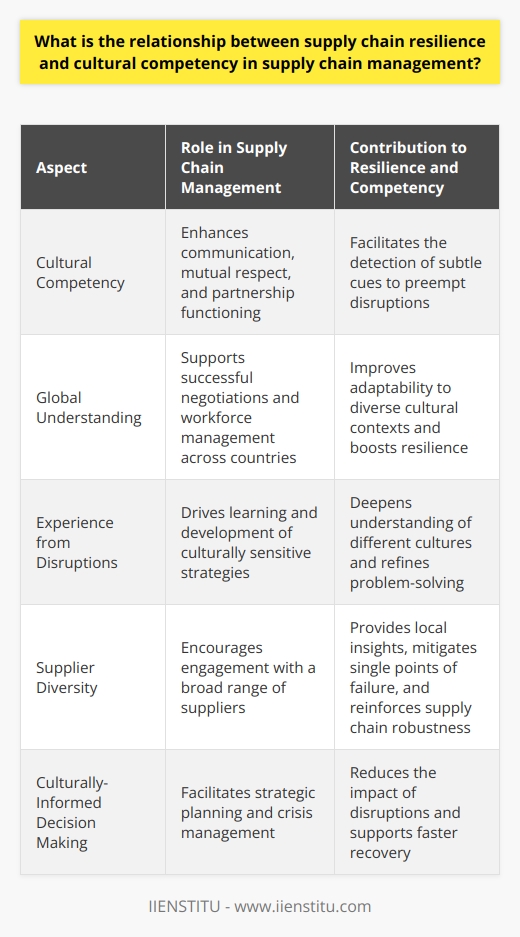
How does culture influence supply chain management?
Cultural Impact on Supply Chain Relationships
Culture plays a significant role in shaping supply chain management by influencing communication, negotiations, and decision-making processes. Diverse cultures bring unique perspectives on business practices, ethical stances, and ways of handling relationships between supply chain partners. Consequently, understanding cultural differences is essential for effective collaboration and integration within the supply chain.
Communication Styles and Decision Making
To begin with, communication styles and preferences vary across cultures, affecting the exchange of information, ideas, and feedback between supply chain partners. For instance, high-context cultures, such as those in Asia, rely on non-verbal cues, trust-building, and indirect communication, while low-context cultures, such as those in North America and Western Europe, value explicit, clear, and direct communication. These differences can lead to misunderstandings, misconceptions, and misinterpretations during negotiations and other interactions within the supply chain.
Additionally, decision-making processes are shaped by cultural values, beliefs, and attitudes. Hierarchical cultures, for example, may rely on top-down decision-making, where leaders have significant authority and control over final decisions. In contrast, egalitarian cultures encourage participative decision-making, where all team members have the opportunity to voice their opinions. The varying decision-making processes present challenges in achieving consensus within culturally diverse supply chain teams.
Ethics and Trust in Supply Chain Management
Cultural differences also affect the ethical standards upheld by supply chain partners and their approach to trust-building. Different cultures perceive ethical behavior and social responsibility in varying ways, and these differences can lead to conflicts when organizations with contrasting values collaborate. For instance, some cultures might prioritize environmental sustainability and fair labor practices, while others are more focused on cost reduction and efficiency driven measures. Understanding and managing these ethical differences is crucial for maintaining the integrity and reputation of the supply chain.
Building trust between supply chain partners is also influenced by culture. Trust is paramount for successful collaboration, and different cultural backgrounds have unique ways of establishing and maintaining trust in relationships. Some cultures rely on personal connections, while others place more emphasis on formal contracts and agreements. Recognizing these nuances is crucial for building lasting partnerships in supply chain management.
In conclusion, culture influences supply chain management through its impact on communication styles, decision-making processes, ethical considerations, and trust-building approaches. By understanding cultural differences and proactively addressing them, supply chain managers can foster productive and collaborative partnerships that enhance the overall effectiveness and efficiency of their operations.

Why is it important to understand the cultural background of a foreign supplier?
Cultural Understanding in Business Relations
Understanding the cultural background of a foreign supplier is crucial for several reasons. Firstly, it helps establish effective communication by acknowledging and respecting cultural differences. Miscommunication can lead to misunderstandings, delays, or even business losses. Therefore, being culturally aware promotes positive collaboration and facilitates negotiations.
Appreciating Business Etiquette
Different cultures have unique business protocols, including negotiation styles, decision-making processes, and etiquette. Showing respect and adapting to these customs not only avoids unintentional offenses, but also demonstrates sincerity and reliability, ultimately fostering trust. Trust is essential for maintaining healthy, long-lasting business relationships.
Accommodating Values and Beliefs
Understanding a supplier's cultural background allows businesses to accommodate differing values and beliefs, which may impact work practices. For instance, religious observances or national holidays might influence working hours, response times, or the ability to conduct business on specific dates. Adjusting expectations and planning accordingly help prevent potential conflicts and disruptions.
Maximizing Professional Networking
Familiarity with the cultural background of a foreign supplier increases the potential for growth and expansion in the international market. Businesses that acknowledge and respect cultural diversity have a better chance of establishing and strengthening their global professional network. It also opens up opportunities for potential collaborations, partnerships, and strategic alliances.
Acknowledging Legal and Ethical Issues
Lastly, cultural awareness is crucial in recognizing and complying with legal and ethical regulations. Variation in laws, social practices, and norms across different countries may pose challenges for businesses. To ensure that contractual agreements, product safety, and labor practices adhere to international standards, businesses must understand their foreign suppliers' cultural background.
In conclusion, understanding the cultural background of a foreign supplier is essential for effective communication, respecting business etiquette, accommodating values and beliefs, maximizing professional networking, and acknowledging legal and ethical issues. Proactively engaging in cultural understanding strengthens business relationships, ensures smoother operations, and promotes overall success in global market endeavors.
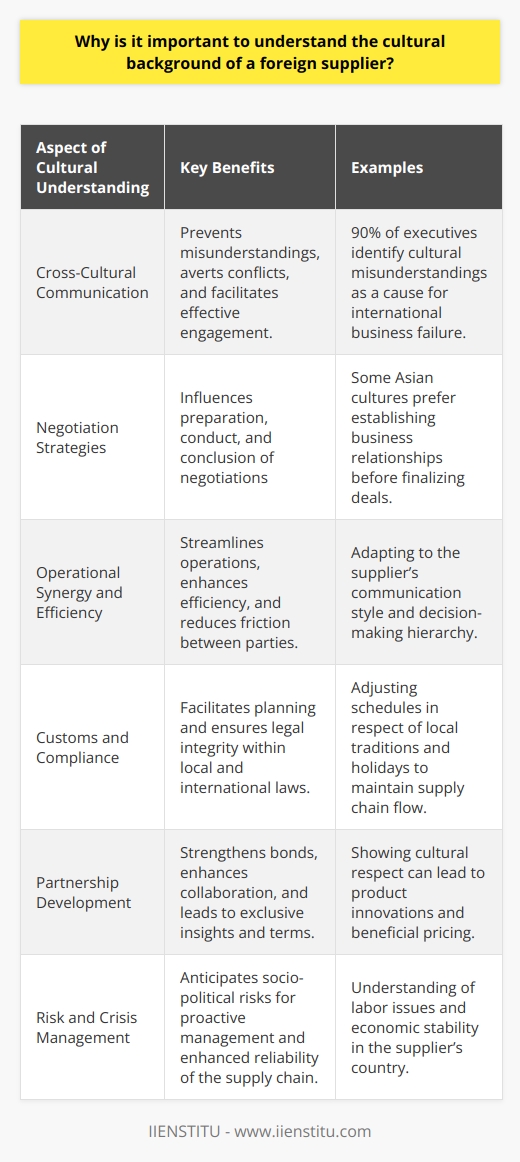
What is the relationship between supply chain and supply chain management?
Defining Supply Chain and Supply Chain Management
Supply chain refers to the series of steps and processes involving the production, movement, and delivery of goods from suppliers to end-users. It encompasses all activities, organizations, and resources required to create a product or service and bring it into the hands of customers. On the other hand, supply chain management (SCM) is the systematic coordination and integration of these activities, focusing on optimizing the flow of goods, information, and resources throughout the entire supply chain.
Key Elements of the Relationship
The relationship between supply chain and supply chain management is intrinsic, as the latter exists to organize, enhance, and control the former. SCM aims to improve the efficiency, effectiveness, and sustainability of the supply chain by implementing various strategies, methodologies, and tools. This relationship can be further understood by exploring key elements, including collaboration, risk management, and technology.
Collaboration in the Supply Chain
Effective supply chain management necessitates collaboration among different stakeholders, such as suppliers, manufacturers, logistics providers, and retailers. Strong partnerships and communication channels form the foundation of a well-functioning supply chain. SCM fosters such collaboration to ensure the smooth functioning of the supply chain, which in turn leads to better customer satisfaction, reduced costs, and increased profits.
Risk Management in the Supply Chain
Supply chain disruptions, whether natural or man-made, pose significant risks to businesses. Supply chain management is responsible for identifying, assessing, and mitigating these risks through a combination of proactive planning and reactive measures. This effort ensures the resilience and continuity of the supply chain, enabling the involved parties to better manage unforeseen events and minimize their impact on operations.
Technology in Supply Chain Management
Technology plays a crucial role in both supply chain and supply chain management, with advancements significantly influencing the way they function. The adoption of innovative solutions, such as automation, artificial intelligence, and the Internet of Things (IoT), has improved supply chain processes by increasing visibility, reducing errors, and allowing real-time decision-making. Supply chain management leverages these technological advancements to better control and optimize supply chain operations, benefitting all stakeholders in the process.
In conclusion, the relationship between supply chain and supply chain management is one of interdependence, as the latter exists to optimize and manage the processes and activities of the former. This relationship encompasses multiple aspects, including collaboration, risk management, and the adoption of technology, which all contribute to enhancing supply chain efficiency, effectiveness, and sustainability.
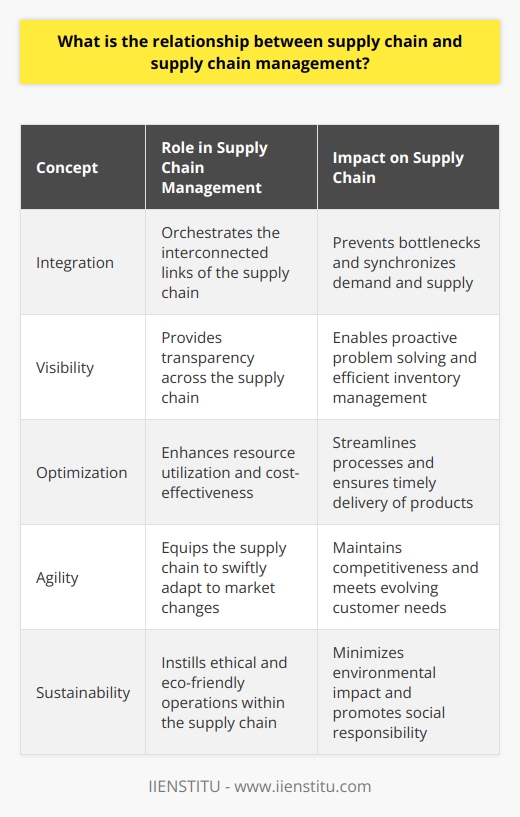
What is the role of culture in promoting collaboration and communication within supply chain management?
Understanding Cultural Influence
Culture plays a crucial role in promoting collaboration and communication within supply chain management (SCM). It sets the tone for how employees and organizational partners interact, influencing their openness and attitudes in daily operations.
Influence on Collaboration
SCM necessitates the close working of individuals from diverse backgrounds. A culture emphasizing respect and mutual understanding encourages a collaborative environment. This eases the flow of ideas and fosters innovation. Consequently, it helps in solving complex supply chain issues like demand forecasting, inventory management, and logistics planning.
Enhancement of Communication
Effective communication is crucial in SCM. Culture shapes the medium, style, and way of messaging within organizations. A transparent and open communication culture ensures clarity of roles and responsibilities, aids better decision-making, and minimizes confusion amongst colleagues. All these contribute to smoother and more efficient supply chain operations.
Fostering Trust and Partnerships
In SCM, it’s vital to establish trust and ensure ongoing collaborations. Culture can aid this by fostering relationships based on trust and mutual understanding. This, in turn, stabilizes the supply chain, nurtures long-term partnerships, and reduces operational risks.
Overall, culture serves as the backbone for the effective functioning of the supply chain. Hence, creating and maintaining a positive organizational culture supporting collaboration and communication is foundational in achieving SCM success.
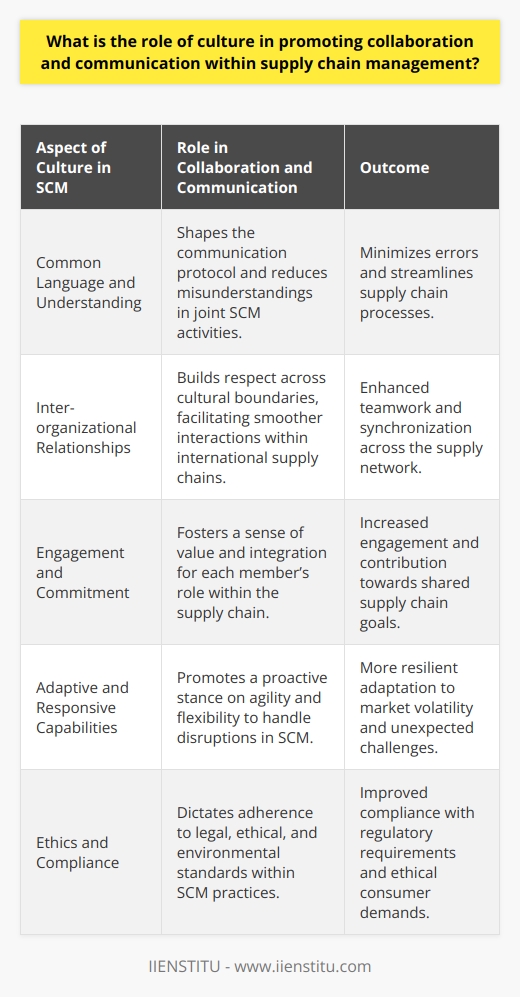
How might cultural competence improve decision-making processes in supply chain management?
Understanding Cultural Contexts
Cultural competence plays a significant role in supply chain management. Understanding cultural contexts, norms, and expectations can aid in creating more efficient decision-making processes. It can lead to a smoother operation by removing potential misunderstandings or misconceptions.
Enhanced Communication
Cultural competence bolsters communication within the supply chain network. Improved communication leads to quick problem resolution and efficient decision making. It encourages respect and understanding, reducing the chances of conflict.
Risk Management
Culturally competent supply chain management can also improve risk management. Awareness of cultural variables helps in predicting potential risks and in devising effective mitigation strategies. This risk anticipation can lead to better decision-making outcomes.
Improved Negotiations
In negotiations, cultural competence plays a pivotal role. Understanding cultural nuances can improve negotiation strategies and outcomes. The result can be better pricing, favorable terms, and stronger partnerships.
Trust Building
Establishing a sense of trust within the supply chain is paramount. Cultural competence helps in building this trust. It demonstrates respect and understanding of diverse viewpoints, aiding in forging stronger relationships.
Understanding Consumer Needs
Cultural competence allows supply chain management to better understand consumer needs. Fairly interpreting these needs results in more effective decision-making processes, leading to customer satisfaction and increased profits.
In conclusion, cultural competence is a critical factor that improves decision making in supply chain management. It fosters improved communication, enhances risk management, aids in negotiations, builds trust, and helps in understanding consumer needs. With these benefits, cultural competence should be a priority in supply chain management.
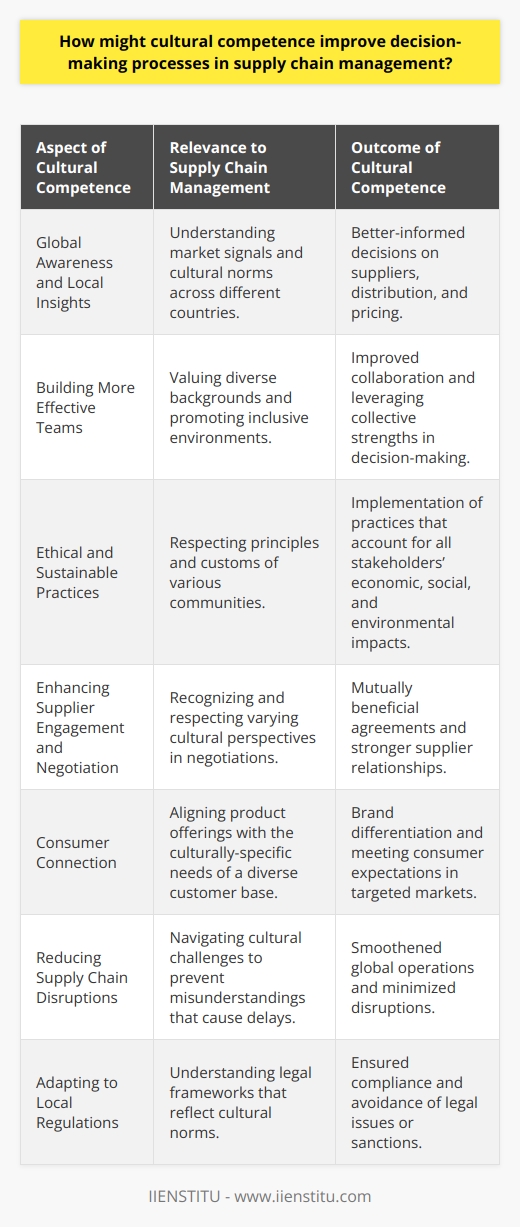
In what ways can cultural differences between stakeholders present challenges to supply chain management, and how can organizations address these challenges?
Understanding Cultural Differences
Supply chain management may confront challenges due to cultural differences among stakeholders. These differences can impact business etiquette, communication styles, negotiation tactics, and decision-making processes.
For instance, different perceptions of punctuality can create scheduling conflicts. Likewise, variations in communication styles can lead to misunderstanding or misinterpretation of information, negatively impacting collaborative efforts.
Addressing Cultural Challenges
Organizations can mitigate these cultural complications in several ways. Promoting cultural awareness is crucial. Organizations can conduct cultural training sessions to acquaint their employees with the norms, customs, and business manners of different cultures.
Bridging Communication Gaps
Moreover, clear and respectful intercultural communication is essential. Companies could encourage the use of unambiguous language during communication, minimizing the possibility of confusion or offense. Active listening and feedback can help to ensure understanding.
Inclusion and Respect
Another significant strategy is creating an inclusive and respectful environment. An inclusive culture treats each stakeholder with respect, regardless of their cultural background. It can eliminate bias and prejudice, and promote equal opportunities for all.
Sourcing Local Talent
Furthermore, employing local talent can provide a better understanding of the native market and helps to establish strong relationships with local suppliers and customers.
Flexibility and Adaptability
Finally, organizations should display flexibility and adaptability. They ought to respect different cultural practices and adjust their working styles accordingly.
In summary, cultural differences indeed bring challenges to supply chain management, but organizations can address them through cultural understanding, effective communication, an inclusive environment, utilization of local talent, and by demonstrating flexibility. In this way, cultural diversity can be transformed from a challenge into a strategic advantage.



